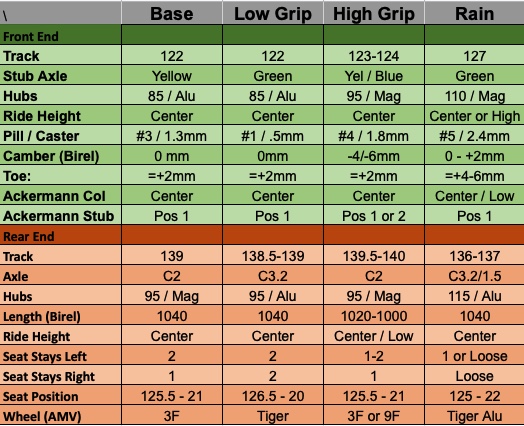One thing to note when you are running harder tires and on a green track (like club racing) is that you might not get the kart to lift and work exactly how you want, simply because there isn’t enough force being generated. When we ran YDS tires (significantly harder than YLC), our goal was more to get the kart to slide ever so slightly, because that was the only way to keep the inside wheel from scrubbing in the corners, because it would never lift.
I question the hopping you describe. On a YLC with a baseline OTK setup and a low-grip track, I’m not sure how you could be hopping, and if you were, that would mean you are definitely generating lift. What tire pressure are you running, and are you sure it’s not just a rough track causing the hop you’re feeling?
If the MXJ is helping, that makes sense, because it’ll generate more heat and grip, so that would be a good wheel for the conditions. The cut axle would help in low-grip situations, so that would be my default axle (and actually is for most conditions) in your situation.
The rest of your setup sounds like it’s pretty close to where it needs to be. I understand you’re just asking this for your information and knowledge, but I would caveat all this for others with the notion that you shouldn’t be chasing some arbitrary time just because paddock talk has you thinking your setup is wrong. If your pace is good then I wouldn’t worry about what you “should” or “shouldn’t” be running for a setup, and rather just focus on your individual handling deficiencies. We used to get a dozen setup opinions from a dozen people in the paddock racing at the club, and it was all different advice.
“Run your weight at the top of the seat!”
“No run it at the bottom!”
“Go up on gear, run this RPM.”
“Drop gear, run this RPM.”
With your driver size, you’re basically perfect for low-grip situations, as you’ve got the body weight to toss around and work the kart. Keep that in mind as well, because you might be able to run a more normal setup than others since you can adapt the handling with some body english too.
My advice would be to test the caster and front width, as that would be a normal setup change to increase the kart’s ability to lift, but remain focused on perfecting your own individual setup and don’t worry too much about what setup other people think you need to run. 

